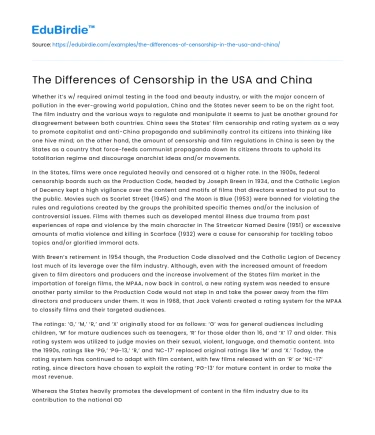Whether it’s w/ required animal testing in the food and beauty industry, or with the major concern of pollution in the ever-growing world population, China and the States never seem to be on the right foot. The film industry and the various ways to regulate and manipulate it seems to just be another ground for disagreement between both countries. China sees the States’ film censorship and rating system as a way to promote capitalist and anti-China propaganda and subliminally control its citizens into thinking like one hive mind; on the other hand, the amount of censorship and film regulations in China is seen by the States as a country that force-feeds communist propaganda down its citizens throats to uphold its totalitarian regime and discourage anarchist ideas and/or movements.
In the States, films were once regulated heavily and censored at a higher rate. In the 1900s, federal censorship boards such as the Production Code, headed by Joseph Breen in 1934, and the Catholic Legion of Decency kept a high vigilance over the content and motifs of films that directors wanted to put out to the public. Movies such as Scarlet Street (1945) and The Moon is Blue (1953) were banned for violating the rules and regulations created by the groups the prohibited specific themes and/or the inclusion of controversial issues. Films with themes such as developed mental illness due trauma from past experiences of rape and violence by the main character in The Streetcar Named Desire (1951) or excessive amounts of mafia violence and killing in Scarface (1932) were a cause for censorship for tackling taboo topics and/or glorified immoral acts.
With Breen’s retirement in 1954 though, the Production Code dissolved and the Catholic Legion of Decency lost much of its leverage over the film industry. Although, even with the increased amount of freedom given to film directors and producers and the increase involvement of the States film market in the importation of foreign films, the MPAA, now back in control, a new rating system was needed to ensure another party similar to the Production Code would not step in and take the power away from the film directors and producers under them. It was in 1968, that Jack Valenti created a rating system for the MPAA to classify films and their targeted audiences.
The ratings: ‘G,’ ‘M,’ ‘R,’ and ‘X’ originally stood for as follows: ‘G’ was for general audiences including children, ‘M’ for mature audiences such as teenagers, ‘R’ for those older than 16, and ‘X’ 17 and older. This rating system was utilized to judge movies on their sexual, violent, language, and thematic content. Into the 1990s, ratings like ‘PG,’ ‘PG-13,’ ‘R,’ and ‘NC-17’ replaced original ratings like ‘M’ and ‘X.’ Today, the rating system has continued to adapt with film content, with few films released with an ‘R’ or ‘NC-17’ rating, since directors have chosen to exploit the rating ‘PG-13’ for mature content in order to make the most revenue.
Whereas the States heavily promotes the development of content in the film industry due to its contribution to the national GDP and its global influence, China heavily restricts and regulates the release of films that contain varied content that could be detrimental to its citizens, in fear of losing the control and support of its people. The different types of content that China regulates include but are not limited to: violence, political issues, racial issues, mental illness, and specific types of both sexual and romantic relationships, especially concerning the inclusion of LGBT representation. Great movies such as, The Life of Wu Xun (1950), Beijing Bastards (1993), and Seven Years into Tibet (1997) were banned in China without possibility for release with censorship for years, until the Chinese government faced backlash when they gained praise at international film festivals or from international leaders.
With the globalization of the world and the influence of the internet, China had initially banned interaction of film industries in Chinese provinces in the importation of foreign films until 1978, and still not opening up all of its borders to outside influence until as late as 2013. Many of the movies in China are pushed by film directors through Chinese allowed government apps that replace YouTube, Twitter, and Facebook as follows: YŌUKÙ TǓDÒU, WĒIBÓ, and RÉN RÉN, thus allowing for the further control of what was Chinese citizens could interact with online, gain information about, and participate in.
China’s rating system also depends solely on the heavy censorship present in China, or films are classified otherwise as ‘banned’ by the official representatives of the Chinese government.
For example, in movies that tend to be LGBT focused or have a significant part of the plot that focuses on an LGBT relationship, China mandates by law, that unless the predominantly LGBT relationship dissolves or one and/or both lovers die by the end of the movie, the movie will not see release. This has led to films such as Happy Together (1997), Hold You Tight (1998), and Irresistible Love (2016) being forced to change their endings upon release or become banned.
The various ways the States and China’s governments regulate the film industry are more similar than different. Even with the States and China’s constant battles over morality and freedom of expression, both depend heavily on each other’s film industry to support their political and economic strategies. Whether it’s through ratings systems, condemnation, or banishment of films, both countries have used heavy censorship in their own way to meet their own goals.






 Stuck on your essay?
Stuck on your essay?

